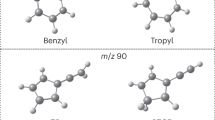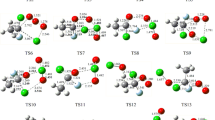Abstract
OZONE is a vital component of the atmosphere. Knowledge of its properties is important to the understanding of its involvement in chemical and photo-induced reactions which can affect the stability of the ozone concentration in the upper atmosphere. The reactivity of ozone and its unusually low thermochemical stability with respect to partial dissociation are difficult to reconcile with an apparently multiply bonded symmetric bent structure. This has led to speculation1,2 concerning alternative forms of ozone such as the equilateral triangular cyclic form (isoelectronic with cyclopropane) from which facile partial dissociation could be envisioned. To have an important role such a form would presumably need to be thermally accessible from the ground state and bound with respect to partial dissociation. The spectroscopic structure determination of the symmetric bent ground state3–10 has been finalised10 (re (O–O) 127.1 pm, angle 116.8°), and there was recently experimental confirmation11,12 of excited states of this species13–16,22 which are bound with respect to dissociation, including the predicted 3B2 state13–17,22. Investigations of bound excited states which are stable to partial dissociation have been stimulated by the sequential observation during O2 radiolysis experiments12,18,19 of two short-lived ‘ozone precursors’ O3α and O3β following recombination of ground state O2 and O. O3β may be vibrationally excited ground state ozone20, whereas the O3α precursor which shows absorption12 at ∼ 315 nm in the ultraviolet (and possibly21 the emission observed at 1500 cm−1 in the infrared) has not yet been given an identity beyond an apparent lifetime of 5 µs. The species showing the single infrared emission21 is interesting as D3h cyclic ozone is expected to show one (degenerate) infrared active fundamental, fewer than any alternative structure. Theoretical evidence for the stability of cyclic ozone has been conflicting. In 1973 Wright1 calculated it to be 26 kJ mol−1 more stable than the ground state; in 1972 and 1975 Hay et al.13,22 calculated it to be less stable by ∼ 150kJ mol−1 (that is, above partial dissociation energy ΔH° = 101 kJ mol−1) and in 1974 Shih et al.14 have concluded it is 63 kJ mol−1 above the ground state. Shih et al.14 have recognised that considerable uncertainty still exists in their computation on total and relative energies, and their calculated ground state structural parameters differ significantly from experiment. We have reinvestigated the relative stability of cyclic ozone and symmetric bent ozone and have obtained a total energy for the ground state of−224.7710 hartree which is 471 kJ mol−1 lower than the previous best model wavefunction of Hay et al.13 who predicted cyclic ozone to be above dissociation. In other words, the relative shortcoming in total energy in all previous computations on each conformer has been around five times the key energy difference between ground state ozone and the partial dissociation products, ΔH° = 101 kJ mol−1. The computed optimum geometric parameters (bond length re = 126.4pm and bond angle αe = 117.3°) are sufficiently close to the experimental values to lend some confidence to our model wavefunctions in regard to structural predictions. The corresponding wavefunction for cyclic ozone has an energy expectation of−224.7637 hartree at an optimum bond length of re = 143.5 pm (bond angle 60°). On this evidence the difference in the energy of the local minima on the ozone ground state conformation hypersurface is less than one fifth of the partial dissociation energy. We, therefore, confidently predict the existence of a bound species of ozone having an equilateral triangle conformation. We believe this species may be the O3α precursor, which in the experiments referred to18,19 is presumably vibrationally excited.
This is a preview of subscription content, access via your institution
Access options
Subscribe to this journal
Receive 51 print issues and online access
$199.00 per year
only $3.90 per issue
Buy this article
- Purchase on Springer Link
- Instant access to full article PDF
Prices may be subject to local taxes which are calculated during checkout
Similar content being viewed by others
References
Wright, J. S. Can J. Chem. 51, 139 (1973).
Pauling, L., The Nature of the Chemical Bond (Cornell Univ. Press, Ithaca, 1960).
Hettner, G., Pohlman, R. & Schumacher, H. J. Z. Phys. 91, 372 (1934).
Schand, W. & Spurr, R. A. J. Am. Chem. Soc. 65, 179 (1943).
Badger, R. M., & Wilson, M. K. J. chem. Phys. 18, 998 (1950)
Trambarulo, R., Ghosh, S. N., Burrus, C. A. & Gordy, W. J. chem. Phys. 21 851 (1953).
Kaplan, L. D., Migeotte, M. V. & Neven, L. J. chem. Phys. 24, 1183 (1956).
Hughes, R. J. chem. Phys. 24, 131 (1956).
Danti, A. & Lorde, R. C. J. chem. Phys. 30, 1310 (1959).
Tanaka, T. & Morino, Y. J. molec. Spectrosc. 33, 538 (1970).
Swanson, N. & Celotta, R. J. Phys. Rev. Lett. 35, 783 (1974).
Riley, J. F. & Cahill, R. W. J. chem. Phys. 52, 3297 (1970).
Hay, P. J., Dunning, T. H. & Goddard III, W. A. J. chem. Phys. 62, 3912 (1975).
Shin, S., Buekner, R. J. & Peyerimhoff, S. D. Chem. Phys. Lett. 28, 463 (1974).
Wilson, C. W. & Wahl, A. C. Proc. Intl. Conf. Computers and Chem. Res. in Educ. 2, 133 (1973).
Karo, A., Krauss, M. & Wahl, A. C. Int. J. Quant. Chem. 75, 143 (1973).
Wahl, A. C., Benioff, P., Das, G. & Wilson, C. W. Report, Argonne National Lab., Argonne, IL, 60439 (1973).
Hochanadel, C. J., Ghormley, J. A. & Boyle, J. W. J. chem. Phys. 48, 2416 (1968).
Bevan, P. L. T., Johnson, G. R. A. J. Chem. Soc. Faraday Trans. I, 69, 216 (1973).
von Rosenberg, C. W. Jr, & Trainor, D. W. J. chem. Phys. 61, 2442 (1974).
von Rosenberg, C. W. Jr, & Trainor, D. W. J. chem. Phys. 63, 5348 (1975).
Hay, P. J., Dunning, T. H. & Goddard III, W. A., Chem. Phys. Lett. 23, 457 (1973).
Dooley, R. & Burton, P. G. at 2nd Intl. Congress in Quant. Chem., New Orleans, April 1976.
Huzinaga, S. Approximate Atomic Functions I (University of Alberta, 1971).
Meyer, W. Intl. J. quant. Chem. S 5, 59 (1971).
Ahlrichs, R., Driessler, F., Lischka, H., Staemmler, V. & Kutzelnigg, W. J. chem. Phys. 62, 1225 (1975).
McEwan, M. J. & Phillips, L. F. Chemistry of the Atmosphere (Edward Arnold, London, 1975).
Author information
Authors and Affiliations
Rights and permissions
About this article
Cite this article
BURTON, P., HARVEY, M. Theoretical evidence for metastable cyclic ozone. Nature 266, 826–827 (1977). https://doi.org/10.1038/266826a0
Received:
Accepted:
Issue Date:
DOI: https://doi.org/10.1038/266826a0
This article is cited by
-
Stability of Hartree-Fock solutions and potential-energy surfaces in a reaction involving inversion of the filled and vacant MO of reagent and product
Journal of Structural Chemistry (1987)
Comments
By submitting a comment you agree to abide by our Terms and Community Guidelines. If you find something abusive or that does not comply with our terms or guidelines please flag it as inappropriate.



